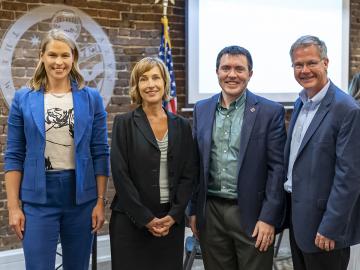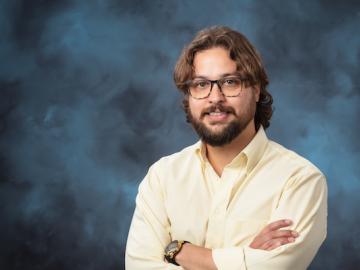
Filter News
Area of Research
- Biological Systems (1)
- Biology and Environment (23)
- Computational Biology (1)
- Electricity and Smart Grid (1)
- Energy Science (40)
- Fusion and Fission (21)
- Fusion Energy (4)
- Isotopes (7)
- Materials (23)
- Materials for Computing (3)
- National Security (12)
- Neutron Science (14)
- Nuclear Science and Technology (17)
- Supercomputing (36)
News Type
News Topics
- (-) Artificial Intelligence (79)
- (-) Biomedical (44)
- (-) Energy Storage (37)
- (-) Grid (34)
- (-) Nuclear Energy (71)
- (-) Simulation (44)
- (-) Space Exploration (13)
- 3-D Printing/Advanced Manufacturing (60)
- Advanced Reactors (13)
- Big Data (50)
- Bioenergy (70)
- Biology (82)
- Biotechnology (26)
- Buildings (35)
- Chemical Sciences (37)
- Clean Water (17)
- Composites (12)
- Computer Science (117)
- Coronavirus (20)
- Critical Materials (6)
- Cybersecurity (14)
- Education (2)
- Emergency (3)
- Environment (124)
- Exascale Computing (51)
- Fossil Energy (6)
- Frontier (45)
- Fusion (40)
- High-Performance Computing (82)
- Hydropower (6)
- Isotopes (35)
- ITER (4)
- Machine Learning (40)
- Materials (53)
- Materials Science (64)
- Mathematics (9)
- Mercury (7)
- Microelectronics (3)
- Microscopy (27)
- Molten Salt (2)
- Nanotechnology (21)
- National Security (63)
- Neutron Science (85)
- Partnerships (36)
- Physics (39)
- Polymers (12)
- Quantum Computing (35)
- Quantum Science (49)
- Security (18)
- Software (1)
- Statistics (2)
- Summit (40)
- Transportation (35)
Media Contacts

Tomás Rush began studying the mysteries of fungi in fifth grade and spent his college intern days tromping through forests, swamps and agricultural lands searching for signs of fungal plant pathogens causing disease on host plants.

Gang Seob “GS” Jung has known from the time he was in middle school that he was interested in science.

A crowd of investors and supporters turned out for last week’s Innovation Crossroads Showcase at the Knoxville Chamber as part of Innov865 Week. Sponsored by ORNL and the Tennessee Advanced Energy Business Council, the event celebrated deep-tech entrepreneurs and the Oak Ridge Corridor as a growing energy innovation hub for the nation.

In human security research, Thomaz Carvalhaes says, there are typically two perspectives: technocentric and human centric. Rather than pick just one for his work, Carvalhaes uses data from both perspectives to understand how technology impacts the lives of people.

Oak Ridge National Laboratory physicist Elizabeth “Libby” Johnson (1921-1996), one of the world’s first nuclear reactor operators, standardized the field of criticality safety with peers from ORNL and Los Alamos National Laboratory.

Mechanical engineer Marm Dixit’s work is all about getting electricity to flow efficiently from one end of a solid-state battery to the other. It’s a high-stakes problem

Friederike (Rike) Bostelmann, who began her career in Germany, chose to come to ORNL to become part of the Lab’s efforts to shape the future of nuclear energy.

To achieve practical energy from fusion, extreme heat from the fusion system “blanket” component must be extracted safely and efficiently. ORNL fusion experts are exploring how tiny 3D-printed obstacles placed inside the narrow pipes of a custom-made cooling system could be a solution for removing heat from the blanket.

It’s a simple premise: To truly improve the health, safety, and security of human beings, you must first understand where those individuals are.

A team of researchers has developed a novel, machine learning–based technique to explore and identify relationships among medical concepts using electronic health record data across multiple healthcare providers.


